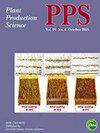Comprehensive assessment of the agronomic, environmental and economic benefits effects of nitrogen fertigation management on maize in Northeast China
IF 1.3
3区 农林科学
Q2 AGRONOMY
引用次数: 0
Abstract
ABSTRACT Seeking economical, efficient and environmentally friendly nitrogen fertigation management strategies is extremely important for sustainable maize production. A two-year field experiment was conducted to investigate the effects of four nitrogen fertilization methods N0: no nitrogen application; FP: applying 234 kg N ha−1 at sowing; NF1: applying 210 kg N ha−1, 50% N at sowing and 50% N fertigation at the V8 stage; and NF4: applying 210 kg N ha−1 sowing: 30%, fertigation at V8: 20%, V12: 20%, R1: 20%, R3: 10% on maize yield, nitrogen and water use efficiency, economic benefits and the environmental assessment in Northeast China. The results showed that compared with the FP treatment, the NF1 and NF4 treatments significantly increased maize yield by 13.2% and 18.6%, increased recovery efficiency of nitrogen (REN) by 38.6% and 68.4%, agronomic nitrogen efficiency (AEN) by 58.6% and 78.2%, water use efficiency (WUE) by 23.8% and 26.9%, and net income by 16.1% and 25.7%, respectively. Additionally, the treatments reduced the apparent nitrogen loss by 69.5% and 96.1%, nitrogen footprint by 34.4% and 37.4% and carbon footprint by 17.0% and 20.8%, respectively. The yield, REN and net income of NF4 were significantly higher than those of NF1 by 4.8%, 21.6% and 8.3%, respectively, and the nitrogen and carbon footprints of NF4 were significantly lower than those of NF1 by 4.6% and 4.6%, respectively. The NF4 treatment was recommended as an effective method for improving yield and net income and reducing the environmental cost while achieving sustainable maize production. GRAPHICAL ABSTRACT东北地区玉米氮肥管理的农艺、环境和经济效益综合评价
寻求经济、高效、环保的氮肥管理策略对玉米可持续生产至关重要。通过为期2年的田间试验,研究了4种不同施氮方式(N0:不施氮;FP:播种时施氮肥234 kg;NF1:播期50%施氮,8期50%施氮,施氮量210 kg ha - 1;NF4:施肥210 kg N ha−1,播量30%,V8: 20%, V12: 20%, R1: 20%, R3: 10%对东北地区玉米产量、氮肥和水分利用效率、经济效益和环境评价的影响。结果表明,与FP处理相比,NF1和NF4处理分别显著提高玉米产量13.2%和18.6%,氮素回收率(REN)提高38.6%和68.4%,氮素农艺效率(AEN)提高58.6%和78.2%,水分利用效率(WUE)提高23.8%和26.9%,净收入提高16.1%和25.7%。氮素表观损失减少69.5%、96.1%,氮足迹减少34.4%、37.4%,碳足迹减少17.0%、20.8%。NF4的产量、REN和净收入分别显著高于NF1 4.8%、21.6%和8.3%,氮足迹和碳足迹分别显著低于NF1 4.6%和4.6%。NF4处理被认为是在实现玉米可持续生产的同时提高产量和净收入、降低环境成本的有效方法。
本文章由计算机程序翻译,如有差异,请以英文原文为准。
求助全文
约1分钟内获得全文
求助全文
来源期刊

Plant Production Science
农林科学-农艺学
CiteScore
5.10
自引率
4.00%
发文量
27
审稿时长
>36 weeks
期刊介绍:
Plant Production Science publishes original research reports on field crops and resource plants, their production and related subjects, covering a wide range of sciences; physiology, biotechnology, morphology, ecology, cropping system, production technology and post harvest management. Studies on plant production with special attention to resource management and the environment are also welcome. Field surveys on cropping or farming system are also accepted. Articles with a background in other research areas such as soil science, meteorology, biometry, product process and plant protection will be accepted as long as they are significantly related to plant production.
 求助内容:
求助内容: 应助结果提醒方式:
应助结果提醒方式:


